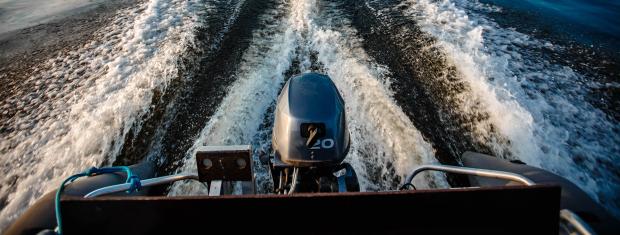
5 Skills Every Boater Should Know
Owning a boat is owning the opportunity to escape whenever you want, wherever you want. However, there is a lot of responsibility that comes with this freedom. You’ll need to hone in on these skills to stay safe on and off of the water:
1. Hitching & Towing
Unless you’ve got a permanent dock on a waterfront property, you need to know the in’s and out’s of hitching your boat to your trailer and towing it safely before it ever touches the water.
Choosing a Boat Trailer
Capacity
Your boat trailer must be the appropriate size to safely tow the weight and size of your vessel. Most trailers have a capacity plate that lists the Gross Vehicle Weight Rating. This figure signifies if the trailer is rated to handle the total weight of your boat, motor, fuel and other onboard equipment. As a general rule of thumb, the load shouldn’t exceed 85% of the trailer’s total capacity.
Fit
Your trailer should allow your boat’s hull to fit snugly on the rollers and other contact points. Using an ill-fitting trailer can result in unbalanced loads and hull damage.
Hitching Up Your Boat Trailer
Follow these steps to ensure your boat trailer is securely fastened to your vehicle before you hit the road:
- Distribute gear evenly in the boat for a balanced load.
- Secure boat tie-downs to ensure the boat doesn’t shift during transport.
- Lower the trailer coupler onto the vehicle's hitch ball and lock the safety pin.
- Connect safety chains in a crisscross "X" pattern to the frame of the towing vehicle.
- Connect trailer lighting cable to vehicle.
- Check that all trailer lights are working.
- If applicable, test trailer brakes and brake lights.
- Check for proper vehicle and trailer tire pressure.
- Check that all fasteners are properly tightened.
2. Sound Signals & Overtaking
You can think of overtaking as you do passing on the road, only it’s on the water. One slight difference on the water is you should utilize a sound signaling device when you plan to overtake another vessel.
 Overtaking: The vessel that wishes to overtake is the Give-Way Vessel. The vessel being overtaken is the Stand-On Vessel.
Overtaking: The vessel that wishes to overtake is the Give-Way Vessel. The vessel being overtaken is the Stand-On Vessel.
When overtaking, the Stand-On Vessel maintains course and speed. The Give-Way Vessel must take early and substantial action to avoid the Stand-On Vessel. You can overtake from either side.
These are the general sound signals used for overtaking:
- I want to pass on your starboard side: One Short Blast
- Proceed: One Short Blast
- I want to pass on your port side: Two Short Blasts
- Proceed: Two Short Blasts
3.Knowing the Knots
Knowing how to tie various knots will come in handy as you secure your boat to different objects. Here are the 5 most basic and essential knots every boater should learn:
- Cleat Hitch – This is the go-to knot for securing your boat to the dock. Wrap the line once around the cleat, then over the top twice, making figure-eight patterns. On the last wrap, rotate the line into a loop and flip it upside down before wrapping it around the cleat. Pull it snug and you’re all set.
- Clove Hitch – This knot will secure your boat to posts, bollards and other fixed objects. Take the end of your rope and make a loop, laying the line over itself. Then make a second loop, again laying the line over itself. Overlap the loops one over the other, slip it over the post you want to tie-off to, and pull snug.
- Bowline - A bowline knot creates a loop in the end of a rope, which won’t slip. Start by making a small loop in your rope about 18 inches from the end. Run the tag end of the line through the loop, wrap it around the main line, then pass it back through the loop again and pull tight.
- Sheet Bend - A sheet bend is used to tie two lines together, and works even if the lines are of different diameters. Start by making a U-shaped loop in the first line, then run the second one through it. Continue wrapping the second line around both looped strands of the first one, then pass the tag end back out through the same loop it came in through, and gently pull tight.
- Square Knot – Another knot used to connect two separate lines. Start by wrapping the two lines together, left over right. Then wrap the tag ends over each other again, this time right over left. Pull the two standing ends apart and you’re done.
4. Docking
Docking a boat can be intimidating and stressful, especially in high winds and/or strong currents. The more you dock, the more experience you’ll gain and the easier it will become. Follow these 7 steps to docking your boat safely:
- Prepare dock lines on your bow and stern and attach fenders.
- Line up your approach and survey the docking area.
- Judge the current, wind, and water conditions.
- Take your time, proceed slowly towards the dock using intermittent acceleration.
- Never approach a dock any faster than you’re willing to hit it.
- Navigate into the boat slip or turn to come alongside the dock.
- Tie off your boat onto cleats, posts, or pilings using your docking lines.
5. CPR & First Aid
Depending on where you take out your boat, medical professionals are often not close by to respond to emergencies. There’s nothing worse than being left helpless in the wake of an emergency. At a minimum, ensure your vessel is equipped with an adequate first aid kit. Consider obtaining a CPR/AED/First Aid certification so your guests don’t feel vulnerable on their voyage.


